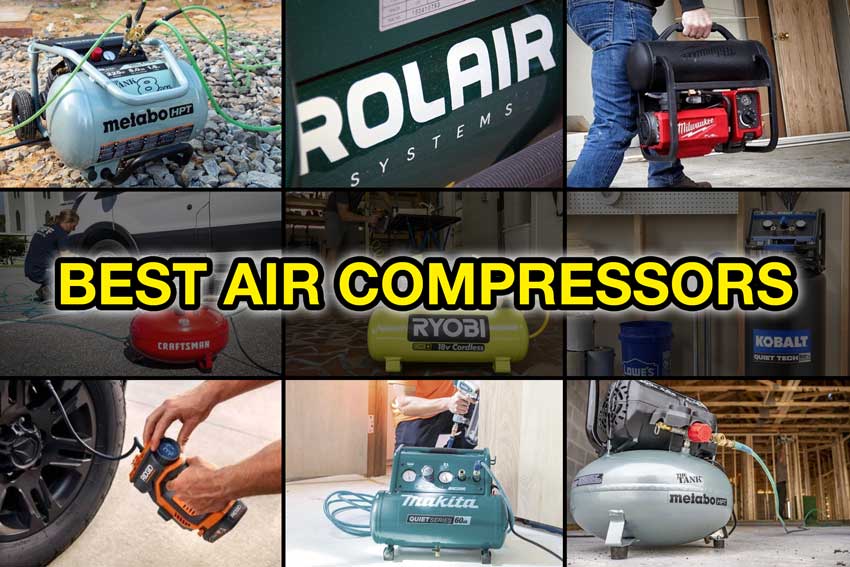When you’re looking for the best air compressor, so much depends on what you’re going to use it for. Construction, automotive, woodworking, aviation, marine, and many others use them to power pneumatic tools, plus there are convenient applications for DIYers.
We’ve used a ton of compressors over the years, from small models for trim work to fully piping out an 80-gallon system for our shop. Whether you’re on the hunt for something portable and quiet, high CFMs for air-hungry tools, or something in between, I have a variety of recommendations for you to consider.
If you’re new to air compressors, I’ll also help you learn the key parts, different types, and the most important things to look for while you’re shopping.
Best Air Compressors – Our Top Recommendations
- Best Overall: Metabo HPT The Tank 8-gal EC1315SM
↓ Jump to this Compressor - Best Small: California Air Tools 1-gal 1P1060S
↓ Jump to this Compressor - Best Quiet: DeWalt XTREME Quiet 4.5-gal DXCMS20045US
↓ Jump to this Compressor - Best Cordless: Metabo HPT 36V 2-gal EC36DAQ4
↓ Jump to this Compressor - Best Gas: Rolair 9-gal 8422HK30-0128
↓ Jump to this Compressor - Best for the Shop: Rolair 5 HP 80-gal V5180K30
↓ Jump to this Compressor - Best Value: Ridgid 6-gal 02106416
↓ Jump to this Compressor
Need Some Help Before You Air Up? Jump to These Section First!
- Air Compressor Parts and Terms To Know
- Types of Air Compressors
- What to Look for When Buying an Air Compressor
- Why You Can Trust Pro Tool Reviews
Best Air Compressor Overall
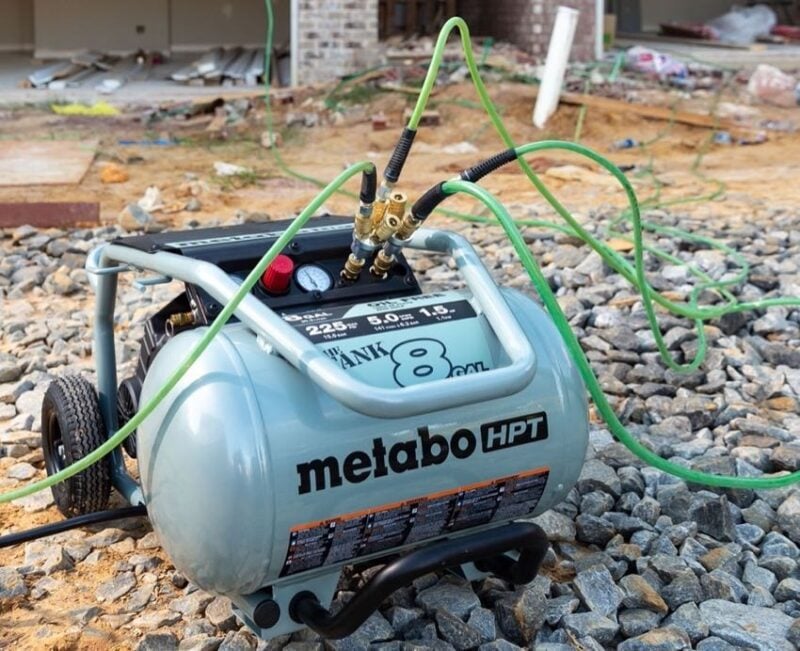
Metabo HPT 8-Gallon EC1315SM
- Tank Capacity: 8 gallons
- Air Delivery @90 PSI: 5 CFM
- Max Pressure: 225 PSI
- Duty Cycle: 50%
- Noise Rating: 76 dBA
- Running Power: 1.5 HP, 13.5A
- Weight: 93 lbs.
- Price: $429
Pros
- High max pressure
- High CFM delivery for its size
- Telescoping handle reduces storage footprint
- Charges from 0 – 125 PSI in under 1 mintue
- Excellent for construction applications
- Oil-free pump
Cons
- Not enough air delivery for high CFM applications like painting and sanding
Metabo HPT’s “Tank” series air compressors offer higher performance than other models in the same class. The lineup’s 8-gallon EC1315SM has the best balance of portability and performance I’ve seen and can handle nearly any construction application. Light enough for one person to transport yet strong enough for a 3-nailer framing crew or 5-nailer trim crew, it delivers an impressive amount of air for its size.
It doesn’t get into the air delivery range for most painting, sanding, and other applications that require high CFMs, but those aren’t the jobs you’d expect this kind of compressor to handle.
Best Small Portable Air Compressor

California Air Tools 1-Gallon 1P1060S
- Tank Capacity: 1 gallon
- Air Delivery @90 PSI: 1.2 CFM
- Max Pressure: 120 PSI
- Duty Cycle: 70%
- Noise Rating: 56 dBA
- Running Power: 0.6 HP, 4.5A
- Weight: 29 lbs.
- Price: $169
Pros
- Higher CFM delivery than other 1-gallon models
- Lightweight
- Extremely quiet
- Full roll cage version available
- Oil-free pump
Cons
- Max PSI is a little lower than others in this class
- Small air compressors have limited capability for powering pneumatic tools
When you’re shopping for a small air compressor, most can only deliver 1 CFM or less at 90 PSI. While this compact class is never going to challenge the performance you get by stepping up to larger, stronger hot dog and pancake models, California Air Tools wasn’t content to simply match the rest of the market. Their 1P1060S (and full-roll cage version 1P1060SP) can deliver 1.2 CFM. That might not seem like a big difference, but it’s 20% more air than other top models competing in this class.
The top pressure is a little lower than the 125 PSI we often see, but at 120 PSI max, it’s unlikely to affect what tools and applications you use it for.
It’s also worth noting that this is an extremely quiet compressor. At just 56 decibels, it’s one of the quietest models available.
Best Quiet Portable Air Compressor
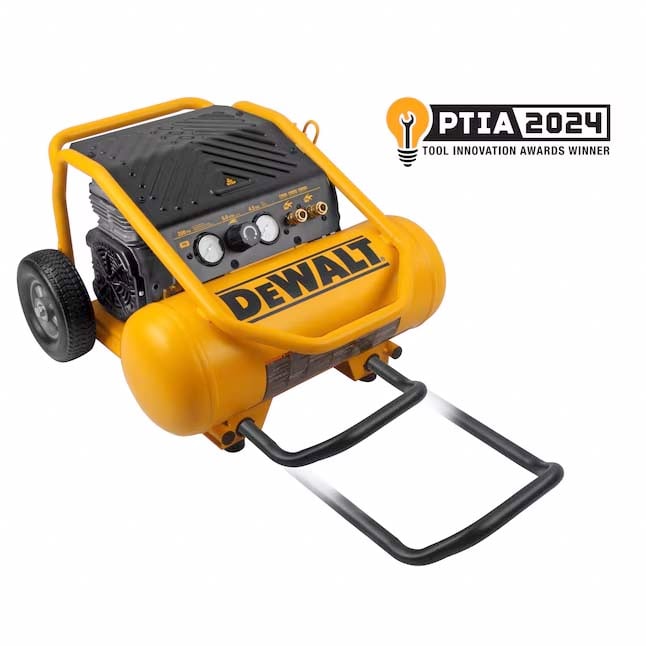
DeWalt XTREME Quiet 4.5-Gallon DXCMS20045US
- Tank Capacity: 4.5 gallons
- Air Delivery @90 PSI: 5.0 CFM
- Max Pressure: 200 PSI
- Duty Cycle: 50%
- Noise Rating: 60.3 dBA
- Running Power: 13.5A
- Weight: 98 lbs.
- Price: $469
Pros
- Quiet operation
- High max pressure
- High CFM delivery for the size
- Excellent for construction applications
- Oil-free pump
- 2024 Pro Tool Innovation Award Winner
Cons
- Not enough air delivery for high CFM applications like painting and sanding
- Expensive
Up until recently, the best quiet air compressor was very limited in performance to the small/compact class. With the launch of DeWalt’s XTREME Quiet series, we now have a mid-range portable model that’s legitimately quiet. At 200 PSI max with 5.0 CFM air delivery, its performance is close to Metabo HPT’s 8-gallon Tank that earned our top overall rating. While DeWalt doesn’t have the same tank capacity as that model, the fact that its operating noise rating is just over 60 decibels is eye-opening and earned it a 2024 Pro Tool Innovation Award.
The only downside is that this model is more expensive than other hot dog compressors in the 4 – 5-gallon range. With its high performance and quiet operation, it’s not a surprise that it comes with a premium price tag, though.
Best Cordless Air Compressor
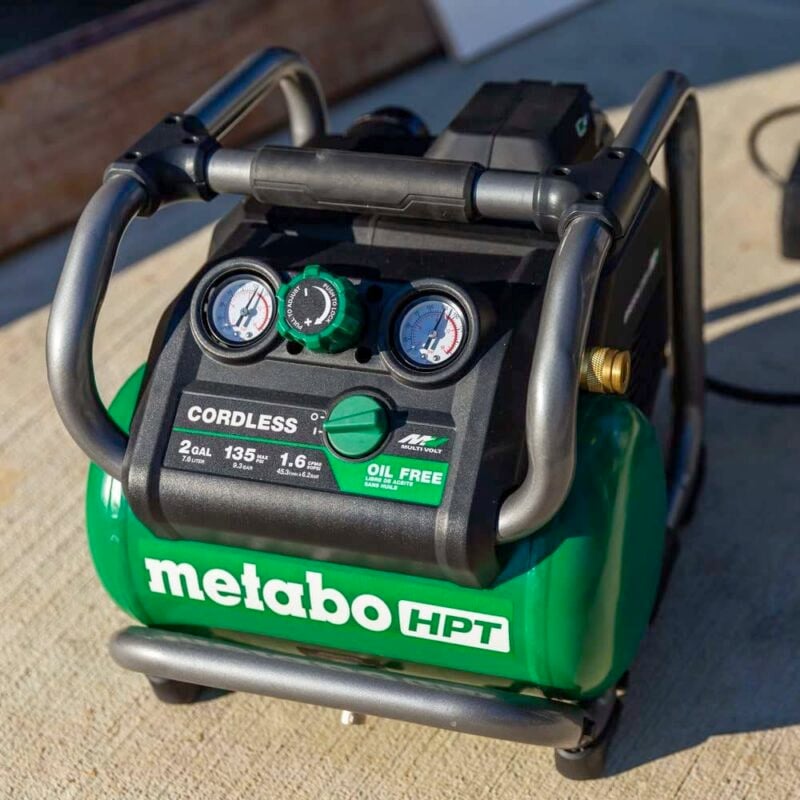
Metabo HPT 36V 2-Gallon EC36DAQ4
- Tank Capacity: 2.0 gallons
- Air Delivery @90 PSI: 2.6 CFM
- Max Pressure: 135 PSI
- Duty Cycle: Not listed
- Noise Rating: 79 dBA
- Motor: 36V brushless
- Weight: 27.3 lbs.
- Price: $299
Pros
- High performance for the cordless class
- Lightweight
- Battery or AC Adapter power options
- Oil-free pump
- 2022 Pro Tool Innovation Award Winner
Cons
- Not as quiet as competing models
Metabo HPT’s 36V EC36DAQ4 raises the bar in performance compared to other battery-powered options, and it easily earns the title of best cordless air compressor. Metabo HPT earns the win partly because of CFM delivery that pushes higher than Milwaukee’s M18 Fuel and DeWalt’s 60V Max. What seals the deal is that it can run on AC power, giving you the option of unlimited runtime when it’s convenient and cordless operation when there’s no power nearby.
The downside is that it’s noticeably louder than Milwaukee. While it’s not obnoxious outside, Metabo HPT’s 79 decibels might not be as welcome on interior jobs as Milwaukee’s 68 decibels.
Best Gas Air Compressor

Rolair 9-Gallon 8422HK30-0128
- Tank Capacity: 9.0 gallons
- Air Delivery @90 PSI: 20.1 CFM
- Max Pressure: 150 PSI
- Duty Cycle: 100%
- Noise Rating: Not listed
- Motor: Honda GX 270
- Weight: 295 lbs.
- Price: $2450
Pros
- Outstanding CFM delivery
- 100% duty cycle
- Honda GX engine
- Active air cooling
- Two-wheel system is more stable than single-wheel designs
Cons
- Louder than electric models
- Expensive
Wheelbarrow compressors are among the largest portable compressors you can get without mounting to a vehicle (vehicles are technically still portable, right?). Construction-focused models can get into the 9 – 10 CFM range, but you can double that and expand the tools you can use by looking at industrial brands.
I like the build Rolair offers on their 8422HK30-0128. Powered by a Honda GX 270 engine with a substantial fan for active air cooling, it produces a massive 20.1 CFM at 90 PSI and has a 100% duty cycle rating. It also employs a two-wheel design, making it more stable than the single center wheel that normally comes on wheelbarrow models.
With a gas engine, it runs louder than electric models. That’s part of the price you pay for having so much more air delivery than a portable electric model can offer. Speaking of price, the price tag is also pretty steep compared to models from construction-focused brands.
Best Shop Air Compressor

Rolair 80-Gallon V5180K30
- Tank Capacity: 80 gallons
- Air Delivery @175 PSI: 18.0 CFM
- Max Pressure: 175 PSI
- Duty Cycle: 100%
- Noise Rating: Not listed
- Running Power: 5.0 HP, 25.6A
- Weight: 495 lbs.
- Price: $2879
Pros
- Outstanding CFM delivery
- 100% duty cycle
- Low RPM belt drive motor reduces noise and extends service life
- Wide range of options to meet your shop’s needs
- Industrial-grade build
Cons
- Requires several weeks’ lead time to build
- Expensive
When I consider the best air compressor for a shop, I immediately think about two brands: Ingersoll Rand and Rolair. While there are certainly excellent options at lower price points (we’ve been using an 80-gallon Northstar in our shop for years), these two brands offer industrial-grade builds designed for the most demanding work environments.
Looking to the single-phase, 5 HP class as a good middle ground for shop compressors, Rolair offers a bit more air delivery and comes in a couple of hundred dollars less than the comparable IR model. Realistically, though, these compressors are an investment, and both brands will serve you very well.
You’re certainly not stuck with only the model I selected, either. You can select from a variety of performance levels, tank capacities, and wiring needs to get what you need for your unique situation. However, Rolair builds these compressors once they’re ordered, so you’ll need to plan for several weeks’ lead time.
Best Air Compressor for the Money

Ridgid 6-Gallon 02106416
- Tank Capacity: 6 gallons
- Air Delivery @90 PSI: 2.6 CFM
- Max Pressure: 150 PSI
- Duty Cycle: Not listed
- Noise Rating: 80 dBA
- Running Power: 1.5 HP, 12.5A
- Weight: 34 lbs.
- Price: $99
Pros
- Excellent value
- Matches the air delivery of more expensive models
- Oil-free
- Usually in stock at your local Home Depot
- Lifetime warranty
Cons
- Not as light as some models in the same class
- Louder than premium options
Finding a good pancake compressor for less than $100 has been tough recently. However, Ridgid launched an updated version of its 6-gallon model that easily earned my pick as the best air compressor for the money.
At 150 max PSI with 2.6 CFM at 90 PSI, it matches the air delivery of much more expensive options and has only slightly lower max pressure than those premium models.
The trade-off is that this one runs a bit louder than some of the premium options and is a few pounds heavier than competing models. It’s not so much of a difference that you should shy away from Ridgid, especially considering how much more affordable this model is at $99 and that it’s backed by a lifetime warranty.
More Compressors We Recommend
Husky 4.5-Gallon 3320445
- Tank Capacity: 4.5 gallons
- Air Delivery @90 PSI: 3.0 CFM
- Max Pressure: 175 PSI
- Duty Cycle: 50%
- Noise Rating: 65 dBA
- Running Power: 1.3 HP, 8.5A
- Weight: 70 lbs.
- Price: $219
If you’re looking for a high-value quiet compressor, Husky has a compelling option over at Home Depot. Producing 3.0 CFM at 90 PSI and with a higher max pressure than most, it’s a solid performer in the twin stack class. Operating at just 65 decibels, you’ll be hard-pressed to find another option that balances performance, noise level, and price this well.
Kobalt Quiet Tech 4.3-Gallon 3320447
- Tank Capacity: 4.3 gallons
- Air Delivery @90 PSI: 2.4 CFM
- Max Pressure: 150 PSI
- Duty Cycle: Not listed
- Noise Rating: 60 dBA
- Running Power: 1.0 HP, 7.5A
- Weight: 62 lbs.
- Price: $249
Kobalt has a sweet little twin-stack compressor that’s easy to transport, runs super-quiet, and is great for a variety of nailing, filling, and other low-CFM applications. It’s relatively small storage footprint and quiet operation make it the one we pull out often when we need a portable compressor, and it’s the one our friends borrow most frequently.
Makita 5.2-Gallon MAC5200
- Tank Capacity: 5.2 gallons
- Air Delivery @90 PSI: 6.5 CFM
- Max Pressure: 140 PSI
- Duty Cycle: 50%
- Noise Rating: 90 dBA
- Running Power: 2.1 HP, 13.8A
- Weight: 88 lbs.
- Price: $459
Makita makes excellent air compressors with super-quiet small options and high-performance Big Bore models. The MAC5200 Big Bore is one to keep an eye on for construction crews. There are some cool features, like integrated tool hangers and onboard accessory storage, but the big deal is the performance. With 6.5 CFM at 90 PSI, it can confidently run a pair of framing nailers or you can add a splitter and run 3 or 4 finish nailers on trim jobs. Plus its highly portable trolley design is easy for one person to manage.
Milwaukee M18 Fuel 2-Gallon 2840
- Tank Capacity: 2.0 gallons
- Air Delivery @90 PSI: 1.2 CFM
- Max Pressure: 135 PSI
- Duty Cycle: Not listed
- Noise Rating: 68 dBA
- Motor: 18V brushless
- Weight: 31 lbs.
- Price: $379 bare tool
Milwaukee very quietly answers the call for a cordless air compressor with a model rated at just 68 decibels and runs on its popular M18 battery system. Its performance and capacity are great for running trim nailers. In our tests, PTR Reviewer Scott Strollo used it for pressure testing lines and bleeding heaters with enthusiastic results. Regardless of the task, the Milwaukee 2840 is sure to more welcome on interior jobs in occupied structures than its cordless competitors.
Ryobi 18V One+ 1-Gallon P739
- Tank Capacity: 1.0 gallons
- Air Delivery @90 PSI: 0.5 CFM
- Max Pressure: 120 PSI
- Duty Cycle: Not listed
- Noise Rating: 78 dBA
- Motor: 18V
- Weight: 14 lbs.
- Price: $149 bare tool
This basic 1-gallon cordless air compressor provides up to 120 PSI and is perfect for DIY woodworking and trim projects along with household inflation duties. With 0.5 CFM at 90 PSI, it won’t run more than a single finish tool nailer, but its light weight and cordless convenience make it a great option for topping off tires before a road trip and inflating those pool toys once summer rolls around.
Air Compressor Parts and Terms to Know

PSI (Pounds per Square Inch): This rating measures how much air pressure the motor can compress into the tank.
CFM/SCFM (Cubic Feet per Minute/ Standard Cubic Feet per Minute): This rating measures the volume of air the compressor can deliver every minute, usually at 90 PSI.
Tank Capacity: Measures how much physical volume the air compressor tank(s) contain.
Tank Charging: Refers to filling the tank and is often used to describe how long it takes to fill/charge the tank from 0 PSI to 90 PSI and/or its maximum pressure.
Regulator: A device that lets you set the pressure you want in the tank so you deliver the appropriate PSI to the tool you’re using.
Duty Cycle: A percentage rating that describes how much time the compressor’s motor can actively operate compared to how much time it needs to rest.
Quick Connect Coupling: A hose connection style that makes it easy to connect air hoses by pushing the male end (hose side) into the female end (compressor side) without the need for any tools or threading.
Tank Drain Valve: A valve on the tank (often a ball valve) that allows you to quickly empty air out.
Types of Air Compressors
We mention several different types of air compressors above. If you’re shopping for your first one, here’s a breakdown of what we mean:
What is a Pancake Air Compressor?
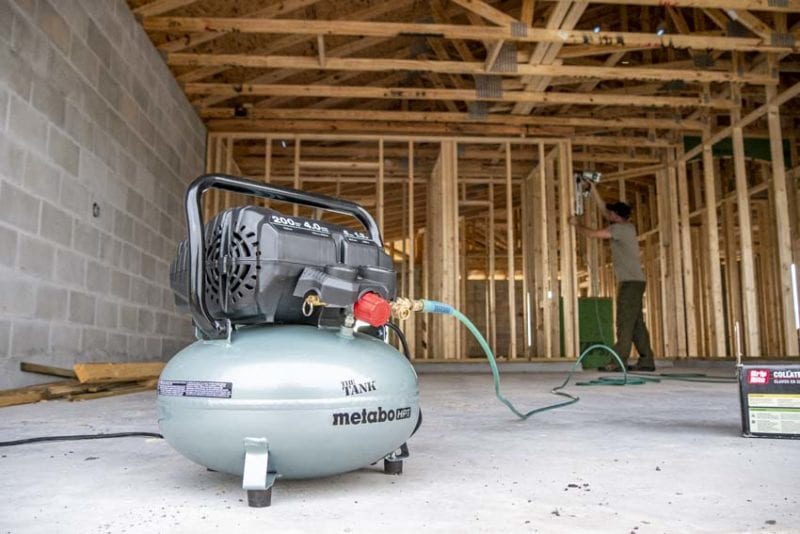
Pancake air compressors use a round, flatter tank style with the motor and pump on top. They’re highly portable and stable with a relatively small footprint. These are a favorite among trim carpenters but I also see a lot of roofers using them due to some models including higher CFM ratings.
What is a Hot Dog Air Compressor?
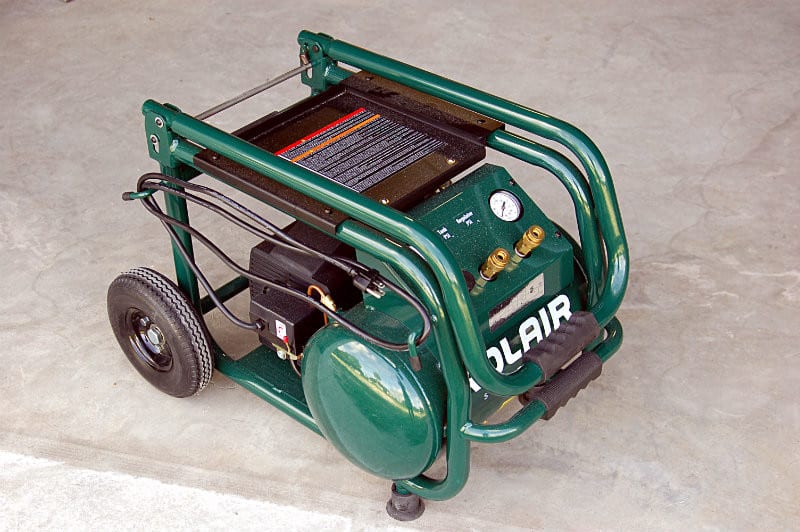
A “hot dog” air compressor uses a single, longer cylinder-shaped tank with the motor and pump up top. Smaller capacity models are similar in footprint to pancake designs while larger capacities tend to take up more room. Some models may include a wheel system built into the frame. Tank sizes vary on these but generally, they fall between 1 and 5 gallons.
What is a Twin Stack Air Compressor?
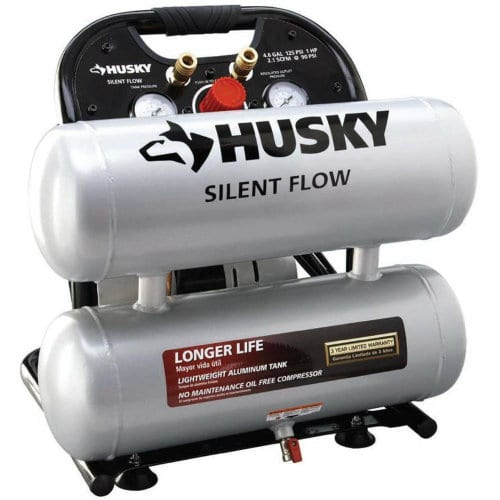
Essentially, a twin-stack air compressor features a double hot dog style. The two tanks can be on the base or stacked on top of one another with the motor and pump shifting from the top to the front side. The advantage is primarily additional capacity. Some models will have a wheel and handle system built into the frame.
What is a Wheelbarrow Air Compressor?

Take a twin-stack air compressor and expand it, and you get a wheelbarrow compressor. These usually feature two high-capacity tanks on the base with a gas engine for its power plant (there are also electric models). A single wheel between the tanks and handles on the opposite side makes it portable despite its much heavier design.
What is a Vertical Air Compressor?
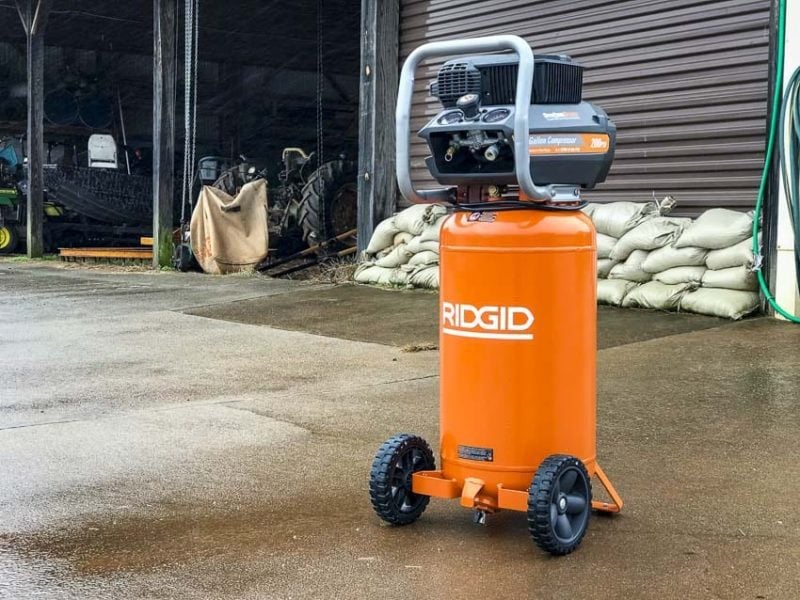
Vertical air compressors use a single high-capacity tank with the motor and pump mounted on top. Smaller models usually have a handle and wheels that you can move around similar to a hand truck. Larger models are designed to be installed and stay in place.
Air Compressor Buying Guide
Power Source
The most common air compressors run on either gas or electric power. Electric models run at either 120V or 240V, depending on the level of performance they have. I prefer electric because of how easy they are to use.
Gas units are usually reserved for jobs that require high air delivery when mobility is a priority. The most common gas models are wheelbarrow styles and are among the largest, heaviest portable air compressors.
Battery-powered air compressors are becoming more popular, and several major power tool brands make them. These are typically lightweight, compact options with lower power that are best for finish nailers and other low-supply applications.
CFM and PSI
When shopping for an air compressor, CFM and PSI are the key specs that tell you the most about the performance you can expect.
CFM lets you know the volume of air the unit can sustain at a particular pressure (usually 90 PSI). Some tools, such as finish nailers, require very little CFM to keep up with the pace of the work. Other tools, like air sanders, need much higher CFM values to keep running.
PSI (pounds per square inch) measures the maximum pressure the pump can put in the tank. The higher the pressure, the greater the amount of air the tank can hold. 125 PSI is a good starting point, and 200 PSI gets you into the high end of the spectrum for the most common units. On the output side, most nailers, ratchets, and sanders require 90-100 PSI.
The reality is that every tool has its own CFM and PSI requirements. Check the package or manual for the tool you’re considering and make sure the air compressor you’re buying handles both. If you have a crew that plans on running multiple tools at the same time, add the CFM requirements together to get your baseline. You don’t have to adjust the PSI requirements.
To make sure you get the most from your compressor, we recommend buying a model that delivers 50% higher CFM than your most air-hungry tool’s needs.
Pro Tip: Drain your air compressor after every use. The air that comes in carried moisture with it and can start to rust the tank from the inside, especially around coastal areas.
Size (Capacity) and Style
Before choosing an air compressor, determine what size you need. Compressors come with tank sizes ranging from 1 gallon to 200 gallons. The larger the tank, the more air it can deliver before recharging. Note that compressors with larger tanks also tend to have larger motors with a higher power demand.
Smaller electric compressors are highly portable. They can run on a generator if you don’t have a direct AC power supply nearby. However, their smaller tanks usually have a lower CFM and can have trouble keeping up with high demand or multiple tools.
On the other hand, larger units tend to be installed in place with air piped to the most convenient locations where you install connectors for your hoses. While these can run more powerful tools, you have to have enough air hose to reach wherever you’re working.
If your compressor’s tank capacity is a little low for your needs, you can add a reserve tank to increase it. Just keep in mind the compressor’s motor will have to work a bit harder to keep both tanks full.
Pro Tip: Every tank has an expiration date. Replace it once you reach that date to ensure the tank doesn’t fail.
Couplers
Most portable air compressors have one or two quick-connect couplers on board. It’s also possible to add a two or three-way splitter. Just be aware that you’re sharing the air and your system needs to work harder to keep up.
Noise Level
Air compressors can be noisy! Add in a small gas engine and they get loud enough that you’ll want hearing protection.
One way to reduce noise is with the drive style. Belt drive compressors run quieter than direct drive by nature. Those tend to only be available on larger models, though.
If you frequently work indoors, in occupied spaces, or around noise-sensitive campuses, look for a quiet compressor. These can drop down below 60 decibels (though most are more) and operate at a level you can actually hold a conversation next to.
Most quiet models are on the lower air delivery side. That means you’re unlikely to find one that’s good for sanding or roofing.
Duty Cycle
Duty cycle is a rating that tells you the percentage of time your compressor can run. For example, a 50% duty capacity tells you it needs 30 minutes of downtime for every 30 minutes of running.
If you’re looking for the best model in a high-use environment, check the rating. Look for a compressor with a 100% duty cycle for high-demand work. For work that doesn’t keep a compressor working to keep up the entire time (most common), a 50% duty cycle is just fine.
Some air compressors can run continuously with a particular amount of airflow guaranteed at the outlet. You find these in industrial applications, and they typically use what’s known as a rotary-screw design. The other kind of continuous duty design involves air supply underwater and for similar applications where a steady flow of air is required from a more portable design.
Pump Type
Without going into a ton of detail about air compressor pumps, there are two basic types: oiled and oil-free. Oil-free models are much more convenient since you don’t have to worry about oil levels and require less maintenance.
Don’t be afraid of splash-lubricated compressors, though. They don’t require a ton of refilling even though you should keep an eye on the levels frequently. In the end, your best bet is the compressor that meets your tools’ requirements whether it needs oil or not.
Why You Can Trust Pro Tool Reviews
Ever check out a “review” site and you can’t tell if they actually tested the tools or if they’re just “recommending” the Amazon top sellers? That’s not us. We only recommend what we’d actually use, even if we don’t earn a commission from it. It’s all about giving you a legitimate recommendation and our honest opinion of each product.
Since 2008, Pro Tool Reviews has been writing reviews and reporting on industry news in the construction, automotive, and lawn care industries. Our Pro reviewers work in the trades and have the skills and experience to know whether tools can perform well in the field.
We also work with dozens of professional contractors around the United States who review products for us on real jobsites and consult with us on testing methods, categories, and weighting. We’ll provide more than 500 pieces of new content this year absolutely free for our readers.
The result is information you can trust because of the editorial, scientific, and real-world professional experience we collectively utilize every time we pick up and test a tool.

